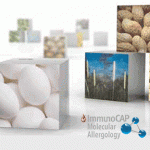New Levels of Allergy Management: Soy Components
Products are for professional/laboratory use only.
An allergy diagnosis is based on the history, clinical symptoms and physical examination of the patient in combination with results of sIgE tests.
ImmunoCAP® Molecular Allergology takes the diagnosis and management of allergy to a whole new level. The technology uses single allergen components to quantitatively detect IgE antibodies. A single blood sample enables measurement to all available ImmunoCAP components, providing precise results for better risk assessment. ImmunoCAP Allergen Components help differentiate “true” allergies from symptoms due to cross-reactivity, evaluate the risk of severe reactions and help in defining the optimal specific immunotherapy treatment. Benefits that ultimately can improve the patient’s quality of life.
Soy protein is an important protein source worldwide. It can be a hidden allergen in a wide variety of processed foods such as meat products, sausages, bakery goods, chocolate or breakfast cereals. Cutaneous and gastrointestinal symptoms are the most common symptoms for soy allergy, but also severe and systemic reactions can occur.
IgE-mediated allergy to soy might be the result of primary sensitization, but could also result from cross-reactivity to birch-related tree pollen and a variety of legumes.
The presence of specific IgE to the storage proteins Gly m 5 and Gly m 6 indicates real soy allergy and risk of severe reactions. Soy-allergic patients with IgE antibodies to Gly m 5 and/or Gly m 6 may also react to similar storage proteins, such as the peanut components Ara h 1 and Ara h 3.
Sensitization to Gly m 4, a PR-10 protein, is common in patients allergic to birch-related tree pollen and indicates risk of reactions to soy. The reactions are often local, but might also be systemic. Up to 10 % of all patients with birch sensitization may also be at risk of reactions to soy.
An increase in soy allergy is likely in many countries due to the promoted health benefits of soy products and the increasing popularity of Asian food. Proper diagnosis of patients with suspected soy allergy improves quality of life.
References:
L’Hocine L, Boye J. Allergenicity of soybean: new developments in identification of allergenic proteins, cross-reactivities and hypoallergenization technologies. Crit Rev Food Sci Nutr 2007; 47:
127–143.
Holzhauser T, et al. Soybean (Glycine max) allergy in Europe: Gly m 5 (beta-conglycinin) and Gly m 6 (glycinin) are potential diagnostic markers for severe allergic reactions to soy. J Allergy Clin Immunol 2009; 123(2): 452–8.
Ito K et al. IgE to Gly m 5 and Gly m 6 is associated with severe allergic reactions to soybean in Japanese children. J Allergy Clin Immunol. 2011 in press.
Kleine-Tebbe J, et al. Severe oral allergy syndrome and anaphylactic reactions caused by a Bet v 1- related PR-10 protein in soybean, SAM22. J Allergy Clin Immunol 2002; 110: 797–804.
Mittag D, et al. Soybean allergy in patients allergic to birch pollen: clinical investigation and molecular characterization of allergens. J Allergy Clin Immunol 2004; 113: 148–154.
Sampson HA. Utility of food-specific IgE concentrations in predicting symptomatic food allergy.
J Allergy Clin Immunol. 2001; 107: 891–6.
Matricardi et al. Primary versus secondary immunoglobulin E sensitization to soy and wheat in the Multi-Centre Allergy Study cohort. Clin Exp Allergy. 2008; 38: 493–500.
Ballmer-Weber B et al. Soy allergy in perspective. Curr Opin Allergy Clin Immunol 2008; 8: 270–275.
Kosma P et al. Severe reactions after the intake of soy drink in birch pollen-allergic children sensitized to Gly m 4. Acta Paediatrica 2011; 100: 305–307.







